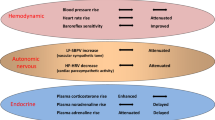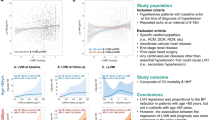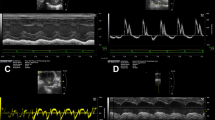Abstract
The spontaneously hypertensive rat (SHR) has been well established as a suitable model for studies of hypertension, but little is known about the processes of left ventricular (LV) hypertrophy and the changes in cardiac function in this model. The present study was designed to provide a noninvasive evaluation of the time-dependent alteration of cardiac function in male SHR at 4 to 24 weeks of age and age-matched Wistar-Kyoto rats (WKY). Echocardiographic studies were performed after blood pressure (BP) and heart rate (HR) were measured by a tail-cuff method. The body weight (BW) of SHR was lighter than that of WKY at all ages, and HR was consistently lower, with significantly elevated systolic BP from 4 weeks of age. In the echocardiographic study, LV mass at 4 weeks of age was similar between WKY and SHR, although the ratio of LV mass to BW was higher in SHR than WKY. The ejection fraction, fractional shortening (FS) and midwall FS did not differ between the two groups at 4 weeks, but after 8 weeks, these parameters were decreased in the SHR. The deceleration time was prolonged in SHR after 16 weeks and the E/A ratio was lowered at 12 weeks. We also analyzed the expression levels of calcineurin, which were found to be increased in both groups with age. These results suggest that calcineurin does not play a major role in the development of LV hypertrophy. Thus, in SHR, cardiac hypertrophy develops by 4 weeks of age, and systolic and diastolic dysfunction is evident at 2 to 3 months.
Similar content being viewed by others
Article PDF
References
Grossman W : Diastolic dysfunction in congestive heart failure. N Engl J Med 1991; 325: 1557–1564.
Levy D, Garrison RJ, Savage DD, Kannel WB, Castelli WP : Prognostic implications of echocardiographically determined left ventricular mass in the Framingham Heart Study. N Engl J Med 1990; 322: 1561–1566.
Kääb S, Dixon J, Duc J, et al: Molecular basis transient outward potassium current downregulation in human heart failure. A decrease in Kv4.3 mRNA correlates with a reduction in current density. Circulation 1998; 98: 1383–1393.
Wilkins BJ, Molkentin JD : Calcium-calcineurin signaling in the regulation of cardiac hypertrophy. Biochem Biophys Res Commun 2004; 322: 1178–1191.
Fiedler B, Wollert KC : Interference of antihypertrophic molecules and signaling pathways with the Ca2+-calcineurin-NFAT cascade in cardiac myocytes. Cardiovasc Res 2004; 63: 450–457.
Trippodo NC, Frohlich ED : Similarities of genetic (spontaneous) hypertension. Man and rat. Circ Res 1981; 48: 309–319.
Boluyt MO, Bing OH, Lakatta EG : The ageing spontaneously hypertensive rat as a model of the transition from stable compensated hypertrophy to heart failure. Eur Heart J 1995; 16 ( Suppl N): 19–30.
de Simone G, Wallerson DC, Volpe M, Devereux RB : Echocardiographic measurement of left ventricular mass and volume in normotensive and hypertensive rats. Necropsy validation. Am J Hypertens 1990; 3: 688–696.
Tanaka N, Dalton N, Mao L, et al: Transthoracic echocardiography in models of cardiac disease in the mouse. Circulation 1996; 94: 1109–1117.
Shimizu G, Hirota Y, Kita Y, Kawamura K, Saito T, Gaasch WH : Left ventricular midwall mechanics in systemic arterial hypertension. Myocardial function is depressed in pressure-overload hypertrophy. Circulation 1991; 83: 1676–1684.
Ganau A, Devereux RB, Roman MJ, et al: Patterns of left ventricular hypertrophy and geometric remodeling in essential hypertension. J Am Coll Cardiol 1992; 19: 1550–1558.
Uemura A, Naito Y, Matsubara T : Dynamics of Ca2+/calmodulin-dependent protein kinase II following acute myocardial ischemia—translocation and autophosphorylation. Biochem Biophys Res Commun 2002; 297: 997–1002.
Laemmli UK : Cleavage of structural proteins during the assembly of the head of bacteriophage T4. Nature 1970; 227: 680–684.
Pfeffer MA, Frolich ED, Pfeffer JM, Weiss AK : Pathophysiological implications of the increased cardiac output of young spontaneously hypertensive rats. Circ Res 1974; 34/35 ( Suppl I): I-235–I-244.
Lee RM, Triggle CR, Cheung DW, Coughlin MD : Structural and functional consequence of neonatal sympathectomy on the blood vessels of spontaneously hypertensive rats. Hypertension 1987; 10: 328–338.
Dang A, Zheng D, Wang B, et al: The role of the renin-angiotensin and cardiac sympathetic nervous systems in the development of hypertension and left ventricular hypertrophy in spontaneously hypertensive rats. Hypertens Res 1999; 22: 217–221.
Takai S, Jin D, Sakaguchi M, Miyazaki M : Significant target organs for hypertension and cardiac hypertrophy by angiotensin-converting enzyme inhibitors. Hypertens Res 2004; 27: 213–219.
Verdecchia P, Schillaci G, Borgioni C, et al: Prognostic value of left ventricular mass and geometry in systemic hypertension with left ventricular hypertrophy. Am J Cardiol 1996; 78: 197–202.
Jiang Y, Qu P, Ding Y, Xia D, Wang H, Tian X : The relation between left ventricular geometric patterns and left ventricular midwall mechanics in hypertensive patients. Hypertens Res 2002; 25: 191–195.
Pfeffer MA, Frolich ED : Hemodynamic and myocardial function in young and old normotensive and spontaneously hypertensive rats. Circ Res 1973; 32/33 ( Suppl I): I-28–I-38.
Kobayashi T, Hamada M, Okayama H, Shigematsu Y, Sumimoto T, Hiwada K : Contractile properties of left ventricular myocytes isolated from spontaneously hypertensive rats: effect of angiotensin II. J Hypertens 1995; 13: 1803–1807.
Okayama H, Hamada M, Kawakami H, et al: Increased contraction of myocytes isolated from young spontaneously hypertensive rat. Relationship between systolic and diastolic function. Am J Hypertens 1998; 11: 349–356.
Cingolani OH, Yang XP, Cavasin MA, Carretero OA : Increased systolic performance with diastolic dysfunction in adult spontaneously hypertensive rats. Hypertension 2003; 41: 249–254.
Shorofsky SR, Aggarwal R, Corretti M, et al: Cellular mechanisms of altered contractility in the hypertrophied heart. Big hearts, big sparks. Circ Res 1999; 84: 424–434.
Slama M, Ahn J, Varagic J, Susic D, Frolich ED : Long-term left ventricular echocardiographic follow-up of SHR and WKY rats: effects of hypertension and age. Am J Physiol Heart Circ Physiol 2004; 286: H181–H185.
Lloyd TR, Donnerstein RL : Afterload dependence of echocardiographic left ventricular ejection force determination. Am J Cardiol 1991; 67: 901–903.
Christe ME, Rodgers RL : Altered glucose and fatty acid oxidation in hearts of the spontaneously hypertensive rat. J Mol Cell Cardiol 1994; 26: 1371–1375.
Iemitsu M, Miyauchi T, Maeda S, et al: Cardiac hypertrophy by hypertension and exercise training exhibits different gene expression of enzymes in energy metabolism. Hypertens Res 2003; 26: 829–837.
Nishimura H, Kubo S, Nishioka A, Imamura K, Kawamura K, Hasegawa M : Left ventricular diastolic function of spontaneously hypertensive rats and its relationship to structural components of the left ventricle. Clin Sci 1985; 69: 571–579.
Brilla CG, Janicki JS, Weber KT : Impaired diastolic function and coronary reserve in genetic hypertension. Role of interstitial fibrosis and medial thickening of intramyocardial coronary arteries. Circ Res 1991; 69: 107–115.
Tahira Y, Fukuda N, Endo M, et al: Transforming growth factor-β expression in cardiovascular organs in stroke-prone spontaneously hypertensive rats with the development of hypertension. Hypertens Res 2002; 25: 911–918.
Mukherjee D, Sen S : Collagen phenotypes during development and regression of myocardial hypertrophy in spontaneously hypertensive rats. Circ Res 1990; 67: 1474–1480.
Sjaastad I, Sejersted OM, Ilebekk A, Bjørnerheim R : Echocardiographic criteria for detection of post infarction congestive heart failure in rats. J Appl Physiol 2000; 89: 1445–1454.
Masuyama T, Yamamoto K, Sakata Y, et al: Evolving changes in Doppler mitral flow velocity pattern in rats with hypertensive hypertrophy. J Am Coll Cardiol 2000; 36: 2333–2338.
Molkentin JD, Lu J-R, Antos CL, et al: A calcineurin-dependent transcriptional pathway for cardiac hypertrophy. Cell 1998; 93: 215–228.
Zou Y, Yamazaki T, Nakagawa K, et al: Continuous blockade of L-type Ca2+ channels suppresses activation of calcineurin and development of cardiac hypertrophy in spontaneously hypertensive rats. Hypertens Res 2002; 25: 117–124.
Zhang W, Kowal RC, Rusnak F, Sikkink RA, Olson EN, Victor RG : Failure of calcineurin inhibitors to prevent pressure-overload left ventricular hypertrophy in rats. Circ Res 1999; 84: 722–728.
Ding B, Price RL, Borg TK, Weinberg EO, Halloran PF, Lorell BH : Pressure overload induces severe hypertrophy in mice treated with cyclosporine, an inhibitor of calcineurin. Circ Res 1999; 84: 729–734.
Roth DM, Swaney JS, Dalton ND, Gilpin EA, Ross J Jr : Impact of anesthesia on cardiac function during echocardiography in mice. Am J Physiol Heart Circ Physiol 2002; 282: H2134–H2140.
Hart CYT, Burnett JC Jr, Redfield MM : Effects of avertin versus xylazine-ketamine anesthesia on cardiac function in normal mice. Am J Physiol Heart Circ Physiol 2001; 281: H1938–H1945.
Author information
Authors and Affiliations
Corresponding author
Rights and permissions
About this article
Cite this article
Kokubo, M., Uemura, A., Matsubara, T. et al. Noninvasive Evaluation of the Time Course of Change in Cardiac Function in Spontaneously Hypertensive Rats by Echocardiography. Hypertens Res 28, 601–609 (2005). https://doi.org/10.1291/hypres.28.601
Received:
Accepted:
Issue date:
DOI: https://doi.org/10.1291/hypres.28.601
Keywords
This article is cited by
-
Antihypertensive effects of the combined extract of Sorghum bicolor, Vigna angularis, and Eleusine coracana in spontaneously hypertensive rats
Scientific Reports (2024)
-
Unilateral chemical ablation of the adrenal gland lowers blood pressure and alleviates target organ damage in spontaneously hypertensive rats
Hypertension Research (2023)
-
Deep phenotyping of miRNAs in exercise-induced cardiac hypertrophy and fibrosis
Journal of Biosciences (2023)
-
Effectiveness of regular physical activity in preventing the progression of arterial hypertension: improved cardiovascular autonomic control during sleep
Hypertension Research (2022)
-
3D imaging and morphometry of the heart capillary system in spontaneously hypertensive rats and normotensive controls
Scientific Reports (2020)



